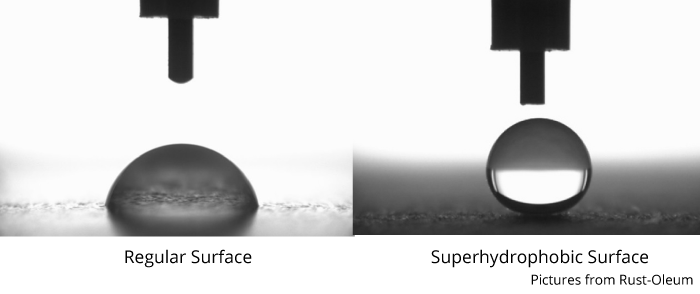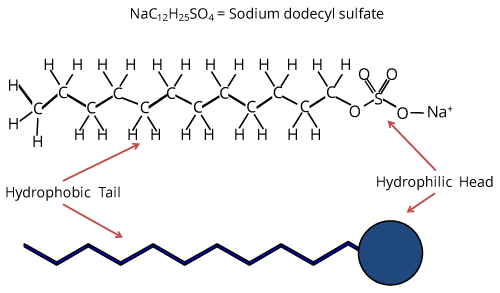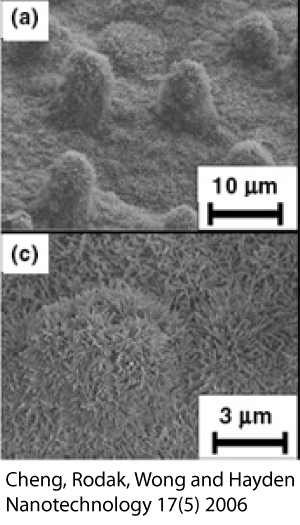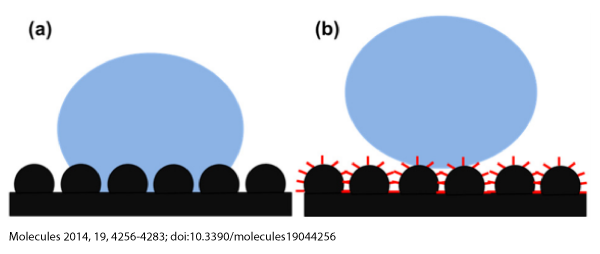While we were waiting for the track to dry at Texas last Saturday, I tweeted a link to my post on why track drying takes so long and how high humidity extends drying time — even with track dryers as powerful as the Air Titan. The short version is that drying a track requires that you
- heat the water so it evaporates; or
- move the water off the track
Unlike the jet dryers, Air Titan does both. This greatly decreases the time it takes to dry a track, but (as we saw Saturday night) it’s still a fairly long process. When you’re talking a night race, you’re talking about a serious impact on the fans, both in the stands and those trying to stay awake at home.
So I started wondering: Can’t science give us a better way to dry racetracks? Or maybe even keep them from getting wet in the first place?
Superhydrophobicity
Science likes big words — mostly because they allow us to be very precise, but also because you sound really smart throwing out words like superhydrophobicity or pseudopseudohypoparathyroidism. Like most big words, you can break down the parts and understand the whole.
Superhydrophobicity
- Super means above, which could be literally (as in superscript) or “better than”. In this case, it means better than.
- Hydro always refers to water.
- Phobicity means having severe dislike (or fear) of something.
So superhydrophobicity simply means something that really, really (really) dislikes water. Compare what happens with water on a regular surface (which isn’t hydrophobic) compared to water on a hydrophobic surface:

The drop on the left experiences a trade-off between the surface tension that wants to make the drop perfectly spherical and the adhesive forces between the water and the surface. So you get a half-drop that spreads out on the surface. If you tilt the surface a little bit, the drop may deform, but it won’t easily roll off the surface.
The right picture is of a hydrophobic surface. In this case, there is little or no adhesive force between the surface and the water. So surface tension wins and you get something pretty close to a spherical water droplet.
In addition to hydrophobic, you may also hear the term oleophobic, which means oil-hating. When you make something hydrophobic, it will repel water. When you make something oleophobic, it will repel oil. Like this (If the video isn’t showing, try this: https://www.youtube.com/embed/BvTkefJHfC0?start=198).
Pretty cool, right? Wouldn’t it be cool if we could do that to a race track? We can already do it with a lot of other things.
- Products for your windshield promise to make water bead off, giving you a clearer view.
- Nissan uses superhydrophobic (and oleophobic) paint that repels water and oil, which means the car doesn’t need washing because it cleans itself.
- “Magic sand” is hydrophobic, which means it can be dumped into water but come out perfectly dry. (Nerd Note: You can make magic sand at home: It’s basically just coating the sand with ScotchGuard). Nerd Note 2: You noticed the sand looks like it’s silvery in the water, right? That’s the effect from a bunch of tiny bubbles forming around the surfaces of the sand grains.


So why don’t we do this for race tracks?
The Origins of Hydrophobicity
There are two ways to make something hydrophobic: by using hydrophobic molecules on the surface or by physically changing the character of the surface. Let’s tackle chemical first. Many molecules have one end that really likes water (which means it hates oil) and another end that really hates water (and likes oil).
Chemical Means
The drawing is of a molecule called Sodium Dodecyl Sulfate (SDS; aka sodium lauryl sulfate). You probably encountered this molecule today if you washed anything, including your clothes, dishes, teeth or hair.

The reason this molecule is used in detergents is because most dirt is oily. The oil-loving end of the molecule gloms onto the dirt and the the water-loving end of the molecule grabs onto the water. When you rise the water away, the dirt goes with it.

Rain-X makes your windshield hydrophobic using fluoroalkylsilanes. One end of those molecules bonds very strongly to glass and the other end is hydrophobic. Basically, you’re putting a layer of molecules between your windshield and the rain.
Physical Means
So let’s look at the other way to make a surface hydrophobic. As is often the case, Nature has already perfected this method. In the East, the lotus became synonymous with purity because lotus plants hang out in muddy, wet, dirty environments — but they stay clean.
Those who dedicate their actions to God, abandoning all attachment, remain untouched by sin, just as a lotus leaf is untouched by water.
— Bhagavad Gita 5.10
The lotus leaf (along with taro, nasturtium, prickly pear, and the alchemilla genus) repels water, but not through chemical means. The plants’ hydrophobicity is critical to their survival: It protects against pathogens like fungi or algae growth and ensures that Sun can reach the leaf surfaces and initiate photosynthesis. A lotus leaf covered with splatters of mud would be like a solar cell with a very dirty surface — it wouldn’t be capable of producing as much energy as it could because not all the light can get through.
We didn’t even start to understand how the lotus was able to do this until the early 1960’s — because the origin of superhydrophobicity is on the micrometer (a millionth of a meter) and nanometer (a billionth of a meter) scale. We simply weren’t able to “see” those scales until the development of specialized microscopes (like the scanning electron microscope) and tools for making structures on these very small scales.

The pictures of a lotus leaf to the right are from an electron microscope. The length bars are just like the ones on a map — they set the scale. (Except in this case, we’re dealing with the very small instead of the very large.) The notation “μm” means micrometer. A normal human hair is somewhere between 70 and 100 μm, so the top picture shows you about half of a hair width’s worth of a lotus leaf.
There are micron-sized protrusions on the surface of the lotus leaf. The lower picture (c) shows a closeup and gives you a better view of what looks like a bunch of ‘hair’ — which is additional roughness, but now on the nanoscale. It is the combination of roughness at the micrometer and nanometer scale that makes a surface highly hydrophobic.
The picture below on the left shows a surface with just the microscale roughness, while the one on the right has micro- and nano-scale roughness. Water settles on one, beads up on the other.

We make this artificially by coating nano- or micro-particles with spiky molecules that mimic the structures of the lotus and its relatives.
Will it Work on Race Tracks?
The answer is (unfortunately) not yet — but researchers are working on it.
The primary interest is roadside safety — decreasing water on roads for safer driving and especially preventing ice buildup. If water doesn’t stay on the road, it can’t freeze and turn into ice. States spend literally millions of dollars pre-treating and treating roadways to prevent or eliminate ice. Also, the chemicals used to do this aren’t always the most friendly to the environment. It makes perfect sense to try to build ice (and water) resistance into the asphalt.
A lot of researchers have found nanoparticle or chemical formulations that show promise. If you search the web, it’ll seem like it’s already a done deal. For example, in 2009, researchers found a superhydrophobic nanoparticle formulation that could prevent ice from forming. But although the headline reads that the material could prevent ice from forming on electric power lines and roads, it hadn’t been tested on roads or power lines. Just two pieces of aluminum standing up straight. That’s still useful, but not from a racing perspective.
Here’s the sticking points in applying this technology to race tracks, in order of difficulty.
- Coming up with a coating that will increase hydrophobicity without decreasing grip. I feel for the poor engineers at Goodyear — they have a zillion challenges already, now we’re going to throw this one at them, too? I couldn’t find any tests of how any of the proposed solutions affected grip, not even at highway speeds. We already have an issue with aerogrip vs. mechanical grip. This type of coating wouldn’t affect aerogrip, but could affect mechanical grip. And losing mechanical grip makes the cars depend more on aerogrip and we know that makes for bad racing.
- Coming up with a coating (either chemical or physical) that will stand up to 500 miles x 40 cars x 200 mph. This includes not only a formulation that won’t break up during the race, but also one that won’t detach itself from the asphalt. We’re talking about much higher temperatures and tractive forces, so this is a much bigger problem for racing than for your neighborhood bridge or overpass.
- Developing a way to apply it that’s easy, uniform, long lasting and affordable.
- Studies of what happens to the coating over time. If it turns into tiny airborne nanoparticles that we breathe, this might not be a great idea.
- How does the coating affect the way the track rubbers up?
So, unfortunately, I think we’re a good 7–10 years away from this being a practical solution to rain delays — but there’s a good probability that the technology will be tested on highways and local roads and might be ported to race tracks, perhaps with modifications.
That doesn’t mean there isn’t an immediate application for superhydrophobicity in NASCAR.
If you’ve ever seem a car coming off the track after a race, you will find that it is DIRTY. It’s got bugs, bits of rubber, grit and everything else on it. That’s not a big deal at a place like Bristol.
But at Daytona and Talladega where drag is a big deal? I’d be looking at the stuff they put on the one guy’s shirt above and see whether putting some of it onto my car might cut down on accumulated grit. Maybe you could find a formulation that could be used on the windshield to minimize the need for tear offs.
And, unless you were really ham handed about it, NASCAR would have a really hard time telling you were doing it.
Please help me publish my next book!
The Physics of NASCAR is 15 years old. One component in getting a book deal is a healthy subscriber list. I promise not to send more than two emails per month and will never sell your information to anyone.
Discover more from Building Speed
Subscribe to get the latest posts sent to your email.


Be the first to comment